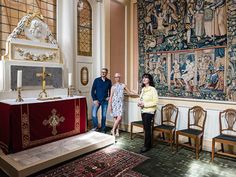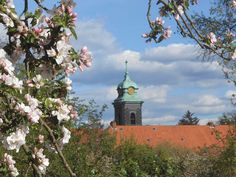Medingen Cloister
The only new cloister of Protestantism in northern Germany
There has been a cloister in Medingen, which was then still called Zellensen, since 1336. After the Reformation it was converted in the year 1559 under the reign of Duke Ernest ("The Confessor") of Brunswick and Lüneburg to a women's convent. The original order had come in the year 1524 but the convent managed to delay conversion to the Lutheran confession for over 30 years in what came to be known as the "Nun Wars". The nunnery's abbess publicly burned all of the Lutheran bibles which had been sent to the Cistercian nuns by Duke Ernest in 1524. During the Middle Ages numerous liturgical songs were written in the Cistercian cloister of Medingen, many of which are still sung (by both confessions) today. Historically significant manuscripts were created, many of which can be found in international libraries today.
Klosterbau wie eine Schlossanlage
During the Middle Ages numerous liturgical songs were written in the Cistercian cloister of Medingen, many of which are still sung (by both confessions) today. Historically significant manuscripts were created, many of which can be found in international libraries today.
The convent is one of six convents in the Lüneburg principality. Most nuns were unmarried daughters of Patrician families here who entered the convent from wealthy households, thereby expanding the possessions of the cloister. As time passed, the cloister acquired rights to the saltern of Lüneburg, to customs fees, to mills and to transport boats on the Ilmenau river. In its hay day, just prior to the Reformation, some 100 nuns lived in Medingen. During the 30-year "Nun Wars" the cloister and all its possessions were seized in 1539 by Duke Ernest the Confessor. He had a part of the cloister torn down. After their reluctant conversion to the Protestant church in 1555, the nuns were given their cloister back again along with some of the seized possessions, but most possessions remained the duke's property.
The way of living in the cloister was gradually relaxed over the years. In 1559 the cloister became a "Protestant convent". The members were allowed to leave the premises briefly or even permanently if they wished to marry. Their upbringing and education as well as their domestic and handicraft skills made many of them popular brides. Today, the Medingen Cloister is still one of the six "Lüneburg Cloisters" in the Heath that have remained in existence since the Middle Ages. All are administered by Chamber of Cloisters in Hanover.
Unmarried Protestant women live here today in a Christian community, each with their own apartment and their own small garden. In contrast to Catholic cloisters, these convents have a primarily social, cultural and artistic function.
The convents do not only accept unmarried women, but also widows and divorced women. Most of the women here today entered the convent after completing their careers. They particularly appreciate the cultivated and Christian atmosphere here along with its focus on community.
With its 18 members, the Medingen Cloister is the largest in Lower Saxony. The head of the convent is, just as was the case in 1494, an abbess. The members are responsible for the artistic treasures of the convent, the passing on of knowledge and regular guided tours. One of the most precious treasures here is the abbess sceptre of 1494, the 15th century golden relict statue of Saint Mauritius, a Gobelin from the 16th century, silver, porcelain and antique trunks and cabinets from the Middle Ages.
The original red brick Gothic architectural style of the original cloister from 1336 can still be seen at the Old Brewery building in the rear section of the cloister grounds. A major fire in 1781 destroyed the remaining buildings. By 1787 the cloister was built as it appears to today in an early classic style. It was the only construction of a Protestant cloister in Northern Germany. In 1788 the new building with its lateral wings was opened as a "Protestant Convent for Noble Women".







